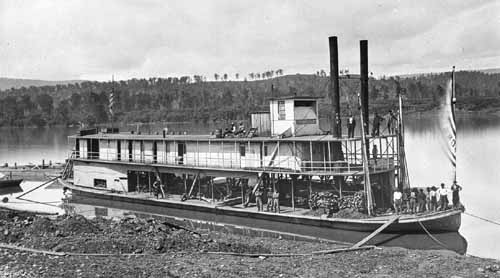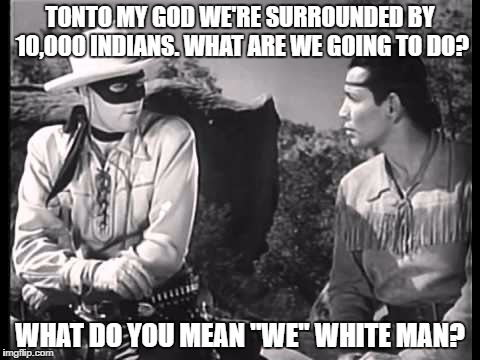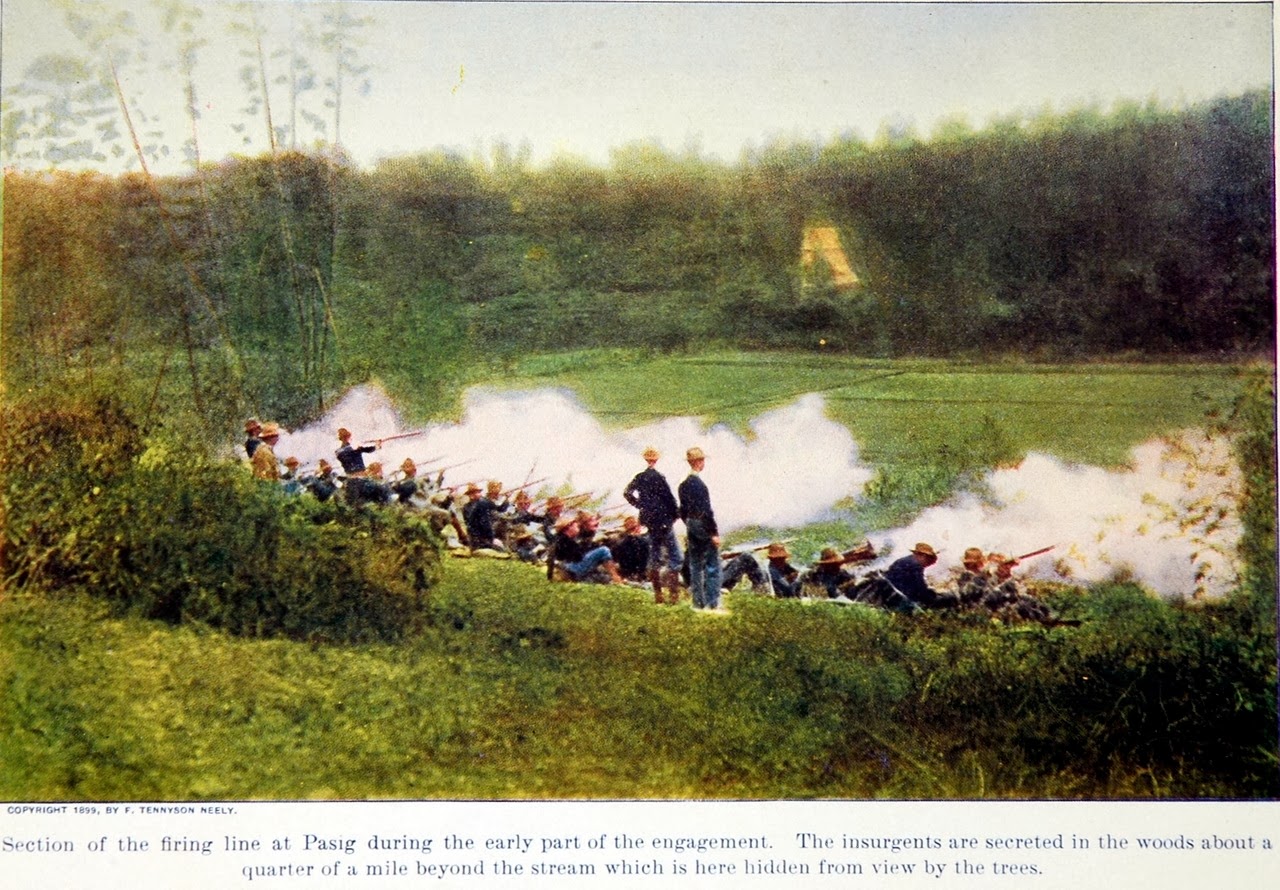The Filipino American War as seen by diarists in real time with some additional commentary and sourc
Feb 4, 2023 19:32:09 GMT
Post by miletus12 on Feb 4, 2023 19:32:09 GMT
Diary of Alfred Burton Welch Saturday 2-4-99
1. The 1st Washington Tobacco Thieves were fighting VERY hard around blockhouse 14. See MAP.

North is image LEFT. The fighting is Image RIGHT, TOP RIGHT and slides to the LEFT as the battle begins.
=====================================================
What did the cockroach see from the Tondo?
Diary of John E.T. Milsaps Saturday, Feb. 4th, 1899
2. Notice that the weather in the Tondo is cool, but elsewhere it is described as "hot"?
3. The reference to the cockroach praying reminds me of King Claudius efforts as depicted in "Hamlet".
4. No Mail at the mailhouse.
5. Rumors of war. See MAP.


6. The Mormons are digging in and posting guns to support the bridgehead the Americans have throwh over the Pasig at the Santa Mesa. This is also where the Filipinos sank that block barge to prevent the USS Luna de Bay from chugging upriver.
7. Summary is that so far the fighting was to the northeast and east. Dewey is shooting north of the Pasig roughly to the east of the modern railway station His monitors are stationed offshore just about 3 km northwest of Fort Santiago.
8. Little sense can be made of the information and rumors except time hacks from what the cockroach hears when shooting happens. What he calls rapid fire guns are GATLINGs.
=====================================================
Diary of Robert Bruce Payne Febr. 4, 1899
Sarcastic comment: American accounts that the Filipinos started the Filipino American War do not hold up when one dives into soldier diary entries, especially among the Nebraskans who were present locally where the incident happened. This one gives a good inkling of what actually happened this date. The source of the outbreak was an incident near the San Juan bridge in the Santa Mesa and it was the Nebraskans who manned that part of the outpost line. M.
====================================================
A Filipino Ilustrado's view of the fighting.
Diary of Santiago Barcelona February 4th, 1899
10. The war criminal, GEN Otis, sent a sham "peace commission" to lull the Aguinaldo government into a truce, while he shored up his inadequate defensive dispositions. I think both sides were shocked and totally surprised at the outbreak of hostilities when the 1st Nebraska Cable Car Absconders, for no apparent good reason, opened fire on Filipino soldiers in the open to their front. But I will have more to write on that incident when I discuss the despicable Ernest W. Hewson.and the 1st California Flour Mill Thieves and their parts of this sad day's events.
11. It is apparent to me from the above diary entries that the Dewey bombardment, north of and east of the Tondo erupted as if on cue from the Nebraskans opening fire on the Filipinos near the Santa Ana pump station. Some Filipino historians think this was supposed to be arranged to look like the Filipino National Liberationists were "advancing on American lines" as I so often read in American accounts of the outbreak of fighting on this day. All I can write, is that Dewey's gunners had their targets and knew where to shoot from the sea. If this was defensive fire, then it took days to plan before implementation becuse you do not fire over the heads of civilians in a city garrisoned by your own troops unless you know exactly what you do and where your shells fall. Not only is it a violation of General Order 100, it is in direct violation of the Laws of War and would have to be sanctioned by and directly requested by... the war criminal, GEN Otis, if it was a spontaneous act. Furthermore, we know from the cockroach's previous diary entries exactly where Dewey positioned the chief bombardment ships, the USS Monterey and USS Monadnock. They were visible from where the cockroach could see them from the Tondo.
12. From Doctor Barcelona's account and via map, we can see that the fighting started near the Pasig north shoreline near the Santa Ana pump station and spread west. This was not what I believe GEN Luna intended, for Ricardo and he had massed the best Filipino forces in the south and southeast to try and overrun the Americans at Cavite and then roll Manila up from the southeast. Instead the fighting broke out in the northeast and the north and quickly took on a shape and character that neither side anticipated.
13. To be clear about 3. Luna adapted quickly and almost pushed Otis into the bay anyway with a combination of hurrah attacks and infiltrations through gaps in the American lines over the next three days. As a consequence the Americans turned savage and the fighting degenerated into mob on mob violence. This was morally reprehensible, but if your backs were to the sea and the enemy pushed you hard, expect Americans to fight like cornered rats.
=====================================================
Diary of James J. Loughrey February 4, 1899
14. Funny way to describe a major firefight that threatened the American position south of the Pasig. See MAP.

=====================================================
I had to heavily edit this entry because of the DESPICABLE attitudes and racist words used by this expletive deleted diarist. This is what the 1st California Flour Mill Thieves saw and did.
Diary of Ernest W. Hewson February 4 (Saturday) 1899
* See thr original diary entry at the link for the original reprehensible wordage. Even in 1899 this wordage was not acceptable, but it was unfortunately all too common among the American line infantry.
15. See MAP.

Pandacan.
16. See MAP.

17. Paco Manila. You can see that the Americans are in big trouble?
=====================================================
Diary of John Henry Asendorf Saturday, February 4th, 1899
18. See MAP.


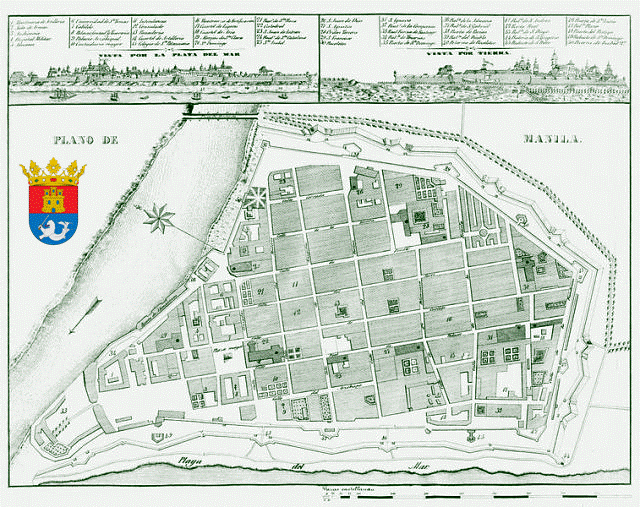
19. The 1st California Flour Mill Thieves were safe behind the walls of the Intramuros, if anywhere could be called safe. The heavy fighting is to the upper left along the Pasig.
Adventures on line b.h. 14.
1. The 1st Washington Tobacco Thieves were fighting VERY hard around blockhouse 14. See MAP.

North is image LEFT. The fighting is Image RIGHT, TOP RIGHT and slides to the LEFT as the battle begins.
=====================================================
What did the cockroach see from the Tondo?
Diary of John E.T. Milsaps Saturday, Feb. 4th, 1899
Manila, Luzon Island — Entry made in parlor of No. 2 Calle Santa Elena, Tondo
A cool breeze reduced the temperature here to such an extent last night that one might feel justified in calling it cold. Reminded me of fall weather in southern Texas. Cloudy today but dry. Cooking breakfast & supper & taking the edge off my appetite with a cold bite at dinner, is a regular feature of everyday life in Manila as my experience runs now.
Since Mrs. Brigadier Brengle wrote me to become a member of the “Acquaintance (with God & the Bible) League”, although I have not joined, I have and am trying to give more time to prayer & bible reading each day.
This forenoon visited the post office but rec’d nothing. Wrote, copied & mailed a letter to Brig. Bruno Friedrich, chief editor of the Canadian War levy, congratulating him on his Christmas number.
Purchased some shells down on the Escolta for my collection. Private Green, B. Battery, Utah Light Artillery dropped in at No. 2. Borrowed of me $1. U.S. coin. Said he would give me $1.50 pay day. Advised him not to give the extra 50 cts. I don't want it in the shape of interest. Green said 4 more cannon were sent out to Camp Santa Mesa today: pieces belonging to the Utah artillery, and more are to follow. Says likewise that reports bring information that 3 Colorado men were killed last night out on picket by natives. War & rumors of war. G likewise said the trains going north are crowded with natives leaving the city. Why they are departing I know not; perhaps the Filipinos expect to rise & burn the city when the attack is made from the outside. Chaplain Stevenson of the Idaho vol. Infantry brought word that he head the foreign consuls have been notified of war.
x x x x
The battle so long expected, has just started. Commenced just as taps were sounding. The roar & rattle of small arms is heard on the outskirts of the city; seems to be over towards the cross-roads –where the Montana troops are stationed. This starts the war. The so-called Filipino Republic is now doomed, –Mrs. Owens is greatly excited. Three Spaniards & mestizos from the lower floor of No. 2 Calle Santa Elena have come up stairs. Excepting the shooting now going on — the city is quiet. The Utah artillerymen –brass band across the street from us, are astir. –Two Filipino women have come up stairs.
The horrid din of war sounds louder. Rapid fire guns are at work. Can hear them above small arms & a call to arms us heard in the artillery qtrs. –Now the thunder of a heavy gun. xx 10.40 p.m. Infantry are now hurrying out Calle Jolo to the front. xxx A lull lasting about half an hour. Now there is disultury [desultory] small arms firing, with the occasional roar of a cannon –apparently from a war vessel. xx The Utah sentries across the street state that some small bullets struck their building –a soldier came over from the Caurtel de Meisig. Says he saw a 3rd Reg’t artilleryman being carried in. In a different quarter the rattle of small arms accentuated with the crash of volleys is now heard. An engagement is in progress –is about 11.30 p.m.–Sleep is out of the question now with the din of war continually sounding, & men getting killed and crippled. xx The rumble of wheels is heard on the streets, probably cannon. –All the Utah cannons are out with the exception of two pieces , which have been left behind for street fighting. xx 25. min. to 12 midnight. Quiet again.
The mestizos of the first floor seem not to care to return to their own part of the house. They are remaining on our floor smoking, talking and keeping me in the qui vive as the battle progresses. xxx Mrs. Owens brought in some cake to refresh the physical man. Is very acceptable at this late hour. —
Past midnight — 12.15 a.m. All quiet, save the whistling of a locomotive over at the R.R. depot.
May God protect our precious Salvation Army comrades who this morning are facing death, likewise the dear Chistians of other denominations. I know some splendid Christians –Salvationists and church members in this 8th army corps —
The sky is clear but no moon is shining. The city electric lights are driving away the darkness & the search lights from Dewey’s fleet are busy this morning.
10 minutes of 3 a.m. Have just been awakened from an uneasy slumber by the renewed noise of battle –which as re-opened. There is a constant sputter with the roar of great guns now & again. Private Frank Amie of H. Battery 3rd Heavy Artillery is in the street below our front window doing patrol duty. Says he is cold. Have thrown him my handkerchief to tie around his neck. xx This is the holy Sabbath of the God of peace, but the awful discord of war is marring its peace. The crescent moon is now shining out brightly. xxx
A cool breeze reduced the temperature here to such an extent last night that one might feel justified in calling it cold. Reminded me of fall weather in southern Texas. Cloudy today but dry. Cooking breakfast & supper & taking the edge off my appetite with a cold bite at dinner, is a regular feature of everyday life in Manila as my experience runs now.
Since Mrs. Brigadier Brengle wrote me to become a member of the “Acquaintance (with God & the Bible) League”, although I have not joined, I have and am trying to give more time to prayer & bible reading each day.
This forenoon visited the post office but rec’d nothing. Wrote, copied & mailed a letter to Brig. Bruno Friedrich, chief editor of the Canadian War levy, congratulating him on his Christmas number.
Purchased some shells down on the Escolta for my collection. Private Green, B. Battery, Utah Light Artillery dropped in at No. 2. Borrowed of me $1. U.S. coin. Said he would give me $1.50 pay day. Advised him not to give the extra 50 cts. I don't want it in the shape of interest. Green said 4 more cannon were sent out to Camp Santa Mesa today: pieces belonging to the Utah artillery, and more are to follow. Says likewise that reports bring information that 3 Colorado men were killed last night out on picket by natives. War & rumors of war. G likewise said the trains going north are crowded with natives leaving the city. Why they are departing I know not; perhaps the Filipinos expect to rise & burn the city when the attack is made from the outside. Chaplain Stevenson of the Idaho vol. Infantry brought word that he head the foreign consuls have been notified of war.
x x x x
The battle so long expected, has just started. Commenced just as taps were sounding. The roar & rattle of small arms is heard on the outskirts of the city; seems to be over towards the cross-roads –where the Montana troops are stationed. This starts the war. The so-called Filipino Republic is now doomed, –Mrs. Owens is greatly excited. Three Spaniards & mestizos from the lower floor of No. 2 Calle Santa Elena have come up stairs. Excepting the shooting now going on — the city is quiet. The Utah artillerymen –brass band across the street from us, are astir. –Two Filipino women have come up stairs.
The horrid din of war sounds louder. Rapid fire guns are at work. Can hear them above small arms & a call to arms us heard in the artillery qtrs. –Now the thunder of a heavy gun. xx 10.40 p.m. Infantry are now hurrying out Calle Jolo to the front. xxx A lull lasting about half an hour. Now there is disultury [desultory] small arms firing, with the occasional roar of a cannon –apparently from a war vessel. xx The Utah sentries across the street state that some small bullets struck their building –a soldier came over from the Caurtel de Meisig. Says he saw a 3rd Reg’t artilleryman being carried in. In a different quarter the rattle of small arms accentuated with the crash of volleys is now heard. An engagement is in progress –is about 11.30 p.m.–Sleep is out of the question now with the din of war continually sounding, & men getting killed and crippled. xx The rumble of wheels is heard on the streets, probably cannon. –All the Utah cannons are out with the exception of two pieces , which have been left behind for street fighting. xx 25. min. to 12 midnight. Quiet again.
The mestizos of the first floor seem not to care to return to their own part of the house. They are remaining on our floor smoking, talking and keeping me in the qui vive as the battle progresses. xxx Mrs. Owens brought in some cake to refresh the physical man. Is very acceptable at this late hour. —
Past midnight — 12.15 a.m. All quiet, save the whistling of a locomotive over at the R.R. depot.
May God protect our precious Salvation Army comrades who this morning are facing death, likewise the dear Chistians of other denominations. I know some splendid Christians –Salvationists and church members in this 8th army corps —
The sky is clear but no moon is shining. The city electric lights are driving away the darkness & the search lights from Dewey’s fleet are busy this morning.
10 minutes of 3 a.m. Have just been awakened from an uneasy slumber by the renewed noise of battle –which as re-opened. There is a constant sputter with the roar of great guns now & again. Private Frank Amie of H. Battery 3rd Heavy Artillery is in the street below our front window doing patrol duty. Says he is cold. Have thrown him my handkerchief to tie around his neck. xx This is the holy Sabbath of the God of peace, but the awful discord of war is marring its peace. The crescent moon is now shining out brightly. xxx
3. The reference to the cockroach praying reminds me of King Claudius efforts as depicted in "Hamlet".
4. No Mail at the mailhouse.
5. Rumors of war. See MAP.


6. The Mormons are digging in and posting guns to support the bridgehead the Americans have throwh over the Pasig at the Santa Mesa. This is also where the Filipinos sank that block barge to prevent the USS Luna de Bay from chugging upriver.
7. Summary is that so far the fighting was to the northeast and east. Dewey is shooting north of the Pasig roughly to the east of the modern railway station His monitors are stationed offshore just about 3 km northwest of Fort Santiago.
8. Little sense can be made of the information and rumors except time hacks from what the cockroach hears when shooting happens. What he calls rapid fire guns are GATLINGs.
=====================================================
Diary of Robert Bruce Payne Febr. 4, 1899
On the evening of this day was placed on guard or rather Cossack outpost at Block house no. 8 in the Santa Mesa district. Our orders were to hold this place and report anything suspicious. A number of recruits had been rec’d on this day by the Filipinos in the shape of wild men from the mountains who were armed with bows and arrows. They wore red breech cloths. [Pvt. James I.] Bowe]s] from our company had been placed on guard. The other private, the corporal and myself had lain down. At about 8 o’clock I heard a rifle shot, a Springfield. We did not pay much attention to this, but directly we heard two more shots. We began to hastily put on our stuff, but before we could get on our belts and haversacks on, firing began on our camp from all sides, and balls began to bing and chug around us. In a minute or two we heard footsteps approaching from camp. It was eight men and a sergeant from C to reinforce the post. Our orders were now to hold the blockhouse and fire only when the enemy advanced in the immediate open and were visible, so during the fire of the night which was incessant we lay sleepless and keeping a sharp watch.
====================================================
A Filipino Ilustrado's view of the fighting.
Diary of Santiago Barcelona February 4th, 1899
It was a beautiful day, Saturday, February 4, 1899.[1] There was peace and happiness everywhere in Malolos because on this day the (peace) Commissioners were to read before Congress the results of the conferences held with the American emissaries of McKinley to reach an agreement between the two nations. Happiness, because the Filipino nation had high hopes that at the end of the conference an agreement favorable to the aspirations of our people would be reached.
In the afternoon, Congress began its session; a numerous public invaded the temple of laws to listen to the outcome of the conferences. Almost all the representatives were at their posts. The session began. Gracio Gonzaga, Secretary of Fomento, representing our government, read the results of the conferences held with the American envoys headed by Schurman,[2] and the Filipinos headed by Florentino Torres.
It was clear that the envoys of the Imperialist Party were not invested with the powers needed to pass any resolution; thus, messages were telegraphed to the McKinley cabinet. In short, nothing was accomplished during the conferences except wasting our time and dampening the spirit of our people.
Coincidence, fatality, Machiavellian stratagem, or concerted action between the American Army and their envoys—the truth is that on that same day, Saturday, February 4, the last groups of soldiers sent by McKinley disembarked at the plains of Santa Mesa with their cannons facing San Juan del Monte, where the advance forces of the Filipinos were stationed. On that day, the talks were terminated without coming to any agreement. Our fears did not take long to come to a head.
The evening was quiet with a silver moon shining; Malolos was happy; a dance was being held in the house of Mrs. Concha del Rosario, widow of Mapúa. Gen. Artemio Ricarte and Col. Luciano San Miguel, commanders of the Santa Ana line in Manila, were paying homage to Terpsichore. While Malolos was in deep slumber without any suspicion of an unrest, between midnight and 1 o’clock in the morning, an unusual noise woke the unsuspecting inhabitants. The cry of “War” reverberated everywhere. The hostilities had begun!
We woke up at 1 o’clock and went to the Central Postal Station, where we met the Honorable President of the Philippine Republic issuing orders. All the prominent members of the government were also there: Gen. Ricarte, Col. San Miguel, [Teodoro] Sandico, and others.
About 3 o’clock, Gen. Ricarte and Col. San Miguel boarded a train for Sta. Ana; Moreno and I accompanied them. At 5 a.m. we reached the station at Caloocan and continued on foot to Maypajo. Before reaching it, Ricarte and San Miguel separated from our group and took the road to La Loma; Moreno and I proceeded to the trenches at Maypajo and reached them at 5:30 a.m. Here we learned of the impossibility of reaching Manila; Moreno has been appointed chief of the volunteers from Manila.
After a while some soldiers from detachments in Solis arrived informing us that they were leaving because they had no longer any cartridges. I left Moreno at 6 o’clock to be in Caloocan with the intention of establishing an emergency field hospital while waiting for the military health unit to take some action. A few steps away sounds of guns and cannons rent the air while shots whistled by, instilling in me the fear that the end was near. During intervals, I made my way and reached unscathed the municipal building where I intended to attend to the wounded. I had hardly gone upstairs when I saw a warship in the bay opposite the building. I left for the railroad station; but barely twenty meters away a grenade fell. I entered the station and saw a wounded man, but as I did not have anything with me to help him, and knowing the impossibility of requesting medicines from Malabon, I departed and took the train for Malolos.
When I arrived home, Choling[3] told me that I was a coward because I had abandoned the fighting. I explained to her that I had come to get bandages and medicines because there were none there. I went to the drug store and requested everything needed for first aid. When I inquired for the cost, the pharmacist refused to collect. At 1 in the afternoon of the 5th, after lunch, I returned to Caloocan bringing my surgery satchel. I found [Antonio] Luna, José, [Leon Ma.] Guerrero and [Anastacio] Francisco, Inspector General of Military Health.
At 4 p.m. a stretcher arrived bringing [José] Torres Bugallon, Major of the General Staff, with a broken right thigh; he was very pale, looking almost bloodless owing to profuse hemorrhage. He stretched his hand upon seeing me, relating at the same time how he had been wounded.
He said, “I was leading the troops when I felt I was wounded, but continued marching about fifty meters farther; then I fell. I felt I was being dragged and then I lapsed into unconsciousness. I did not know anything more until I found myself here today. Bitter and endless fighting continued on both sides.” I asked him to stop talking and he kept silent.
Luna and I applied first aid to him then he was transferred to the Lolomboy Hospital at Bocaue. He died, however, on the way. The body was taken to Malolos, where it was buried. I was left in Bocaue, where I intended to establish a hospital; but with the presence of De Jesus and Cordero of the medical corps, I proceeded to Meycauayan, where I spent the night. On the following day, I stayed in the Polo station to attend to the wounded. On the third day, seeing that the medical staff of the military unit had taken complete control of the situation, I returned to Malolos.
[1] Manuscript carries year of 1900.
[2]Jacob Gould Schurman.
[3]Consuelo de Santos, youngest daughter of Marcelino de Santos; Barcelona married her on July 6, 1901
In the afternoon, Congress began its session; a numerous public invaded the temple of laws to listen to the outcome of the conferences. Almost all the representatives were at their posts. The session began. Gracio Gonzaga, Secretary of Fomento, representing our government, read the results of the conferences held with the American envoys headed by Schurman,[2] and the Filipinos headed by Florentino Torres.
It was clear that the envoys of the Imperialist Party were not invested with the powers needed to pass any resolution; thus, messages were telegraphed to the McKinley cabinet. In short, nothing was accomplished during the conferences except wasting our time and dampening the spirit of our people.
Coincidence, fatality, Machiavellian stratagem, or concerted action between the American Army and their envoys—the truth is that on that same day, Saturday, February 4, the last groups of soldiers sent by McKinley disembarked at the plains of Santa Mesa with their cannons facing San Juan del Monte, where the advance forces of the Filipinos were stationed. On that day, the talks were terminated without coming to any agreement. Our fears did not take long to come to a head.
The evening was quiet with a silver moon shining; Malolos was happy; a dance was being held in the house of Mrs. Concha del Rosario, widow of Mapúa. Gen. Artemio Ricarte and Col. Luciano San Miguel, commanders of the Santa Ana line in Manila, were paying homage to Terpsichore. While Malolos was in deep slumber without any suspicion of an unrest, between midnight and 1 o’clock in the morning, an unusual noise woke the unsuspecting inhabitants. The cry of “War” reverberated everywhere. The hostilities had begun!
We woke up at 1 o’clock and went to the Central Postal Station, where we met the Honorable President of the Philippine Republic issuing orders. All the prominent members of the government were also there: Gen. Ricarte, Col. San Miguel, [Teodoro] Sandico, and others.
About 3 o’clock, Gen. Ricarte and Col. San Miguel boarded a train for Sta. Ana; Moreno and I accompanied them. At 5 a.m. we reached the station at Caloocan and continued on foot to Maypajo. Before reaching it, Ricarte and San Miguel separated from our group and took the road to La Loma; Moreno and I proceeded to the trenches at Maypajo and reached them at 5:30 a.m. Here we learned of the impossibility of reaching Manila; Moreno has been appointed chief of the volunteers from Manila.
After a while some soldiers from detachments in Solis arrived informing us that they were leaving because they had no longer any cartridges. I left Moreno at 6 o’clock to be in Caloocan with the intention of establishing an emergency field hospital while waiting for the military health unit to take some action. A few steps away sounds of guns and cannons rent the air while shots whistled by, instilling in me the fear that the end was near. During intervals, I made my way and reached unscathed the municipal building where I intended to attend to the wounded. I had hardly gone upstairs when I saw a warship in the bay opposite the building. I left for the railroad station; but barely twenty meters away a grenade fell. I entered the station and saw a wounded man, but as I did not have anything with me to help him, and knowing the impossibility of requesting medicines from Malabon, I departed and took the train for Malolos.
When I arrived home, Choling[3] told me that I was a coward because I had abandoned the fighting. I explained to her that I had come to get bandages and medicines because there were none there. I went to the drug store and requested everything needed for first aid. When I inquired for the cost, the pharmacist refused to collect. At 1 in the afternoon of the 5th, after lunch, I returned to Caloocan bringing my surgery satchel. I found [Antonio] Luna, José, [Leon Ma.] Guerrero and [Anastacio] Francisco, Inspector General of Military Health.
At 4 p.m. a stretcher arrived bringing [José] Torres Bugallon, Major of the General Staff, with a broken right thigh; he was very pale, looking almost bloodless owing to profuse hemorrhage. He stretched his hand upon seeing me, relating at the same time how he had been wounded.
He said, “I was leading the troops when I felt I was wounded, but continued marching about fifty meters farther; then I fell. I felt I was being dragged and then I lapsed into unconsciousness. I did not know anything more until I found myself here today. Bitter and endless fighting continued on both sides.” I asked him to stop talking and he kept silent.
Luna and I applied first aid to him then he was transferred to the Lolomboy Hospital at Bocaue. He died, however, on the way. The body was taken to Malolos, where it was buried. I was left in Bocaue, where I intended to establish a hospital; but with the presence of De Jesus and Cordero of the medical corps, I proceeded to Meycauayan, where I spent the night. On the following day, I stayed in the Polo station to attend to the wounded. On the third day, seeing that the medical staff of the military unit had taken complete control of the situation, I returned to Malolos.
[1] Manuscript carries year of 1900.
[2]Jacob Gould Schurman.
[3]Consuelo de Santos, youngest daughter of Marcelino de Santos; Barcelona married her on July 6, 1901
11. It is apparent to me from the above diary entries that the Dewey bombardment, north of and east of the Tondo erupted as if on cue from the Nebraskans opening fire on the Filipinos near the Santa Ana pump station. Some Filipino historians think this was supposed to be arranged to look like the Filipino National Liberationists were "advancing on American lines" as I so often read in American accounts of the outbreak of fighting on this day. All I can write, is that Dewey's gunners had their targets and knew where to shoot from the sea. If this was defensive fire, then it took days to plan before implementation becuse you do not fire over the heads of civilians in a city garrisoned by your own troops unless you know exactly what you do and where your shells fall. Not only is it a violation of General Order 100, it is in direct violation of the Laws of War and would have to be sanctioned by and directly requested by... the war criminal, GEN Otis, if it was a spontaneous act. Furthermore, we know from the cockroach's previous diary entries exactly where Dewey positioned the chief bombardment ships, the USS Monterey and USS Monadnock. They were visible from where the cockroach could see them from the Tondo.
12. From Doctor Barcelona's account and via map, we can see that the fighting started near the Pasig north shoreline near the Santa Ana pump station and spread west. This was not what I believe GEN Luna intended, for Ricardo and he had massed the best Filipino forces in the south and southeast to try and overrun the Americans at Cavite and then roll Manila up from the southeast. Instead the fighting broke out in the northeast and the north and quickly took on a shape and character that neither side anticipated.
13. To be clear about 3. Luna adapted quickly and almost pushed Otis into the bay anyway with a combination of hurrah attacks and infiltrations through gaps in the American lines over the next three days. As a consequence the Americans turned savage and the fighting degenerated into mob on mob violence. This was morally reprehensible, but if your backs were to the sea and the enemy pushed you hard, expect Americans to fight like cornered rats.
=====================================================
Diary of James J. Loughrey February 4, 1899
We were called to arms at 8.35 pm. and recalled at 9.15 p.m. There was a second call to arms at 9.45 p.m. when the Insurgents attacked the Colorado’s outpost. We left the barracks at once and reported to the 6th Artillery Quarters and went from there to Paco Cemetery. We arrived back in our own quarters at 12.30 a.m. on February 5th.

=====================================================
I had to heavily edit this entry because of the DESPICABLE attitudes and racist words used by this expletive deleted diarist. This is what the 1st California Flour Mill Thieves saw and did.
Diary of Ernest W. Hewson February 4 (Saturday) 1899
Some Filipino soldiers landed near our quarters in a boat to day. The boat, an old antidiluvian affair was being towed up river and ran hard aground. It is common supposition that the boat was being taken up river to sink in the middle of the Pasig near Santa Ana so as to prevent our gunboat from navigating further up. The soldiers left for their lines this afternoon.
Later— To night at exactly 10 minutes of nine heavy firing commenced across the river where the Nebraskans are stationed. It continued for some time and then spread areund the line towards Tondo district when the entire line was engaged. Looks as if the fight is on at last.
Our outposts in Pandacan were immediately strengthened by reinforcements from B Company, and additional sentries were strung out over the town of Pandacan.
I was returning to barracks with our quartette. We had been to the house of a rich native spending the evening, and while returning to barracks down one of Pandacan’s streets we discussed the probability of trouble with the Insurgents, and came to concur in that the trouble was about over. No sooner had the call to quarters sounded, and immediately after we had entered the barracks, the shots were heard across the river. All lights were instantly extinguished and the entire company left in barracks prepared for a vigorous defense of the grounds.
The firing continued indiscriminately for possibly a half hour when a cannon was discharged, presumably in the Insurgent lines. Shortly afterwards the calls to arms were sounded all. over Manila, being distinctly heard by us in Pandacan. There was incessant, cheering as the troops fell into line in Manila. All seem to be relieved now that the trouble is on. Now, Mr. (Filipino), look out.
Artillery played throughout the night. Our boys at Dewey and Otis posts, being closest to the (Filipinos), are under a heavy fire to night. Bullets are constantly striking our barracks. The Insurgents have our position well mapped out.
Later— We were re-inforced by F Company, First Washington, late to night. They marched over the road from Paco to Pandacan. As the Washingtons reached Pandacan this road was cut off by the heavy fire of the Insurgent trenches directly in front. We are now cut off from Manila by land, but not. by the river. The (Filipinos) seem to have Pandacan comnletely surrounded.
Desultory firing is going on all along the lines. We are making no attempt to drive the (Filipinos) back, preferring to do that by daylight. The gunboat steamed up the river twice to night but did no firing.
We remained to our guns all night without sleeping. Our house was sprayed with bullets all night long. None were hurt in to night’s skirmish. Our boys and the Washingtons stuck manfully to the outposts, being under a heavy fire all night. They changed their position to avoid the niggers’ fire.
We dont know how the fracas started. The Nebraskans started it by firing into a crowd of advanging *(Filipinos). Good boys, Nebraskas.
Later— To night at exactly 10 minutes of nine heavy firing commenced across the river where the Nebraskans are stationed. It continued for some time and then spread areund the line towards Tondo district when the entire line was engaged. Looks as if the fight is on at last.
Our outposts in Pandacan were immediately strengthened by reinforcements from B Company, and additional sentries were strung out over the town of Pandacan.
I was returning to barracks with our quartette. We had been to the house of a rich native spending the evening, and while returning to barracks down one of Pandacan’s streets we discussed the probability of trouble with the Insurgents, and came to concur in that the trouble was about over. No sooner had the call to quarters sounded, and immediately after we had entered the barracks, the shots were heard across the river. All lights were instantly extinguished and the entire company left in barracks prepared for a vigorous defense of the grounds.
The firing continued indiscriminately for possibly a half hour when a cannon was discharged, presumably in the Insurgent lines. Shortly afterwards the calls to arms were sounded all. over Manila, being distinctly heard by us in Pandacan. There was incessant, cheering as the troops fell into line in Manila. All seem to be relieved now that the trouble is on. Now, Mr. (Filipino), look out.
Artillery played throughout the night. Our boys at Dewey and Otis posts, being closest to the (Filipinos), are under a heavy fire to night. Bullets are constantly striking our barracks. The Insurgents have our position well mapped out.
Later— We were re-inforced by F Company, First Washington, late to night. They marched over the road from Paco to Pandacan. As the Washingtons reached Pandacan this road was cut off by the heavy fire of the Insurgent trenches directly in front. We are now cut off from Manila by land, but not. by the river. The (Filipinos) seem to have Pandacan comnletely surrounded.
Desultory firing is going on all along the lines. We are making no attempt to drive the (Filipinos) back, preferring to do that by daylight. The gunboat steamed up the river twice to night but did no firing.
We remained to our guns all night without sleeping. Our house was sprayed with bullets all night long. None were hurt in to night’s skirmish. Our boys and the Washingtons stuck manfully to the outposts, being under a heavy fire all night. They changed their position to avoid the niggers’ fire.
We dont know how the fracas started. The Nebraskans started it by firing into a crowd of advanging *(Filipinos). Good boys, Nebraskas.
15. See MAP.
Pandacan.
16. See MAP.

17. Paco Manila. You can see that the Americans are in big trouble?
=====================================================
Diary of John Henry Asendorf Saturday, February 4th, 1899
The weather is fine but terribly hot. The company is undergoing a strict inspection of quarters and arms. Everything was ok. Gun [inspection] was especially strict. The outpost came in at 8 o’clock and reported that things were restless on the insurgents’ line but we only sent fifteen men on outpost and seven men on guard duty. Around the quarters the day was rather quiet in the city all day which was broken in the stillness of the night by sudden shots being fired about fifteen minutes after midnight(?) but in a short time there were shots fired all along the line but most of it was near the waterworks where the Nebraska Regiment was encamped. All boys rushed to their respective quarters and dressed for action and, before the call for arms was sounded, every man was already in line each carrying 70 rounds of ammunition. We started off doubletime to Companies H and I quarters in front of the prison “Bilibid.” Here we were joined by the rest of the regiment. The Colonel [Alexander Hawkins] order Company I to guard General [Elwell Stephen] Otis‘ quarters and Company C to patrol our end of the city while the rest went on in double-quick to the front. The firing was now along the line. Some shots even landed in the city. Some [shots] went through the roof of our quarters. Just every place before 10 o’clock the Utah Battery had several guns going. All Filipinos were ordered into their houses. We had but very little trouble in the city. The firing kept on all night.



19. The 1st California Flour Mill Thieves were safe behind the walls of the Intramuros, if anywhere could be called safe. The heavy fighting is to the upper left along the Pasig.














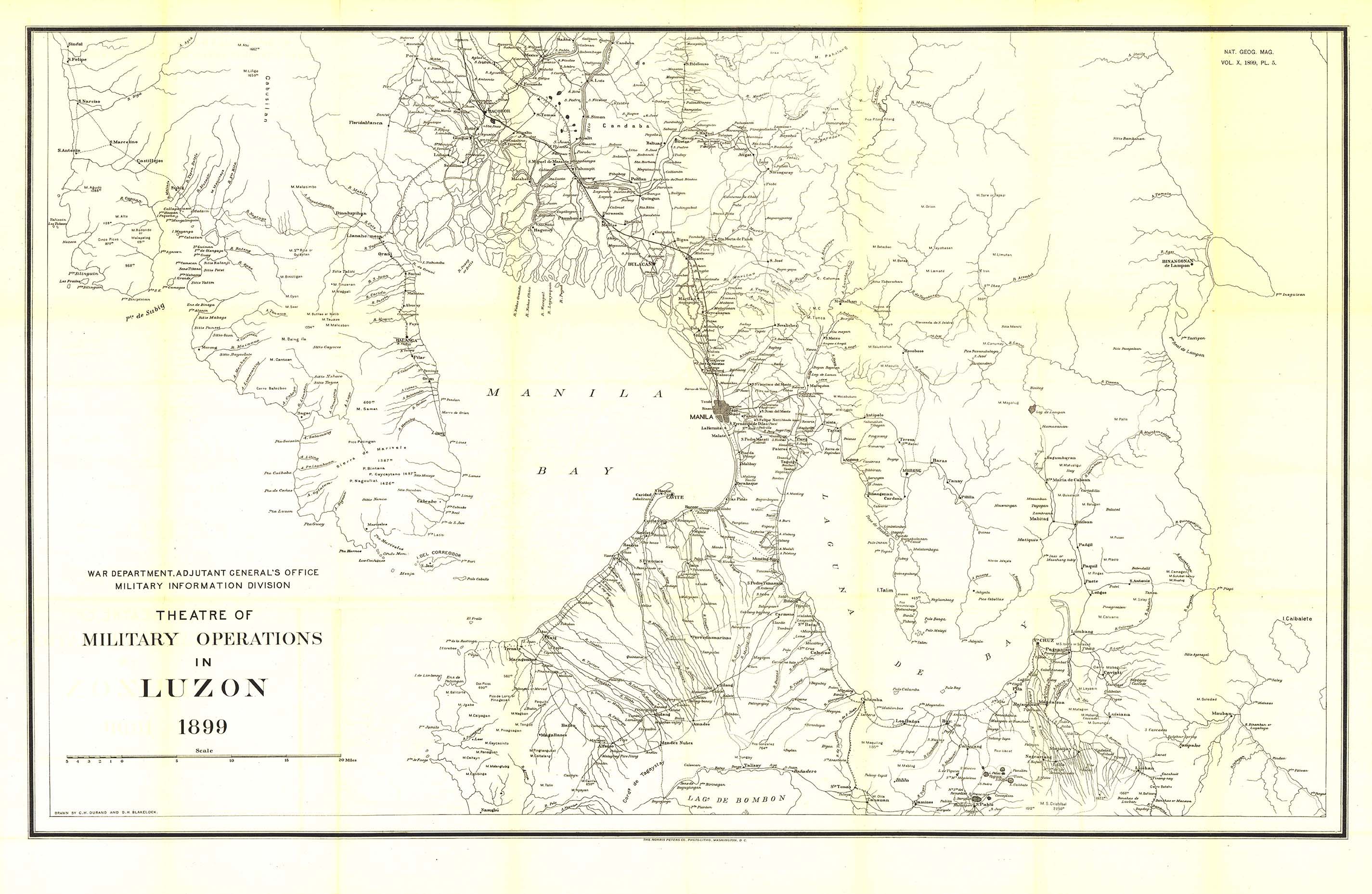







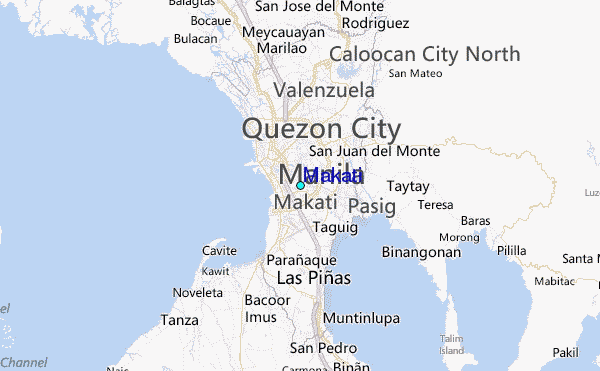







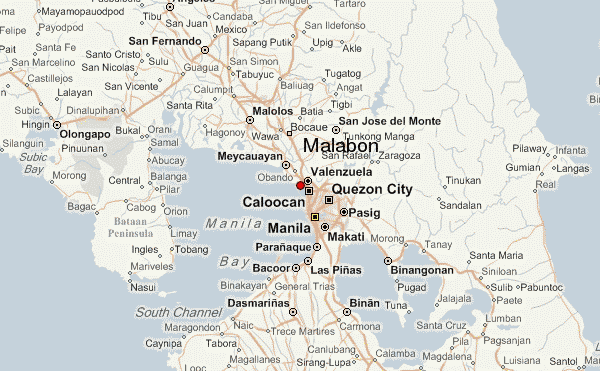
--N015-00_E120-00--N014-00_E121-30.jpg)
